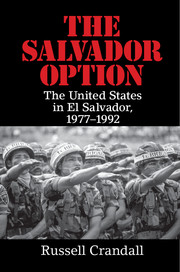Book contents
- Frontmatter
- Dedication
- Epigraph
- Contents
- List of Figures
- List of Organizations
- Acknowledgments
- 1 Introduction
- PART ONE EL SALVADOR IN THE COLD WAR
- PART TWO JIMMY CARTER
- 7 Revolution and Counterinsurgency in Guatemala
- 8 Mass Organizations
- 9 Carter Arrives
- 10 Carter and the Sandinista Revolution in Nicaragua, 1979
- 11 An October Coup
- 12 Carter Engages Salvador
- 13 Archbishop Romero
- 14 Land
- 15 The American Churchwomen
- 16 Arming the Rebels
- 17 Guerrilla Final Offensive, January 1981
- 18 Death Squads
- PART THREE RONALD REAGAN
- PART FOUR GEORGE H. W. BUSH
- PART FIVE POSTWAR
- Notes
- Bibliography
- Index
16 - Arming the Rebels
from PART TWO - JIMMY CARTER
Published online by Cambridge University Press: 05 June 2016
- Frontmatter
- Dedication
- Epigraph
- Contents
- List of Figures
- List of Organizations
- Acknowledgments
- 1 Introduction
- PART ONE EL SALVADOR IN THE COLD WAR
- PART TWO JIMMY CARTER
- 7 Revolution and Counterinsurgency in Guatemala
- 8 Mass Organizations
- 9 Carter Arrives
- 10 Carter and the Sandinista Revolution in Nicaragua, 1979
- 11 An October Coup
- 12 Carter Engages Salvador
- 13 Archbishop Romero
- 14 Land
- 15 The American Churchwomen
- 16 Arming the Rebels
- 17 Guerrilla Final Offensive, January 1981
- 18 Death Squads
- PART THREE RONALD REAGAN
- PART FOUR GEORGE H. W. BUSH
- PART FIVE POSTWAR
- Notes
- Bibliography
- Index
Summary
This revolution goes beyond our borders.
– Tomás Borge, Sandinista commanderSandinista Support for Armed Struggle
El Salvador in 1980 had guerrillas but no guerrilla war – at least not in the formal sense of an organized insurgency. Thus, paradoxically, the “civil war” likely started earlier than we have often imagined despite the fact that the formal guerrilla insurgency began in early 1981. Indeed, until this point the revolutionary forces were eager but “fragmented into competing factions.” And they still lacked a unified command and heavier, more lethal weaponry. This was all about to change. In fact, at least according to inherently biased U.S. intelligence reports written in the mid-1980s, captured FMLN documents revealed that only days after Somoza's ouster in July 1979, Salvadoran guerrilla representatives met in Managua to discuss Sandinista support for armed struggle in El Salvador. Yet it apparently took over a year for external support to get fully under way, something expedited by the Havana-led unification of the disparate Salvadoran guerrilla factions into the FMLN in late 1979 and early 1980.
In mid-October 1980, Havana was the site where alleged representatives of communist parties in Central American and Mexico met and agreed to establish a network to control the provision of materiel for the Salvadoran insurgency. The rendezvous, originally slated for Managua, was moved to Havana at the request of the Sandinistas to obscure their involvement in the transhipments. During this same month, U.S. intelligence observed a sharp increase in flight frequencies that suggested a marked rise in the flow of military equipment into Nicaragua from Cuba. Augusto C. Sandino international airport was closed for regular flights between 10 p.m. and 4 a.m. for several weeks to allegedly “accommodate cargo planes ferrying arms and other equipment from Cuba” – and thus possibly onward to El Salvador.
These sorts of reports prompted an exasperated Carter administration to send a demarche [formal diplomatic representation of the official position] to the Sandinista government indicating that arms shipments to El Salvador would jeopardize the recently approved $75 million in economic development funds from the United States. The Sandinistas responded that while some Nicaraguans might have been involved in such activity, it was not government policy. The Sandinistas held up transhipments for roughly a month despite FMLN requests to keep the arms flowing.
- Type
- Chapter
- Information
- The Salvador OptionThe United States in El Salvador, 1977–1992, pp. 167 - 175Publisher: Cambridge University PressPrint publication year: 2016

